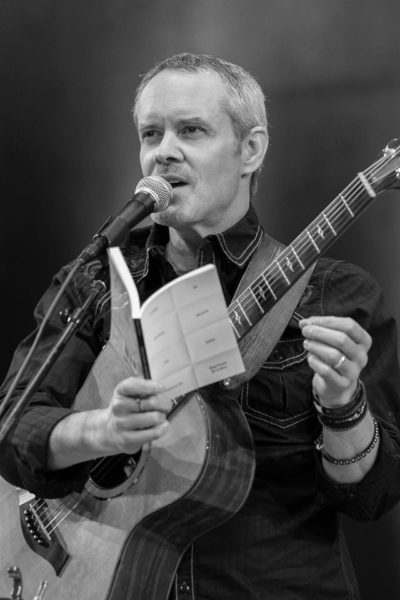In May, we held our fourth Community Conversation about songwriting with Texas Hill Country-based, award-winning poet, songwriter, and teacher, Nathan Brown. I was excited for Nathan to facilitate this session because I took his Fall 2013 songwriting course at Austin Community College while he was Oklahoma’s Poet Laureate, and the songwriting “structures” and principles he taught inspired some of my best songs. That class also sparked the idea to bring a songwriting workshop to Art Spark Texas.
The hour Nathan spent with us was a great refresher for anyone working the craft of songwriting, and the perfect starting point for anyone new to it. These are the pieces of wisdom I found most helpful for my own lyrical practice. If you could not attend our session with Nathan, I highly encourage you to watch the recording at the end of this article. I am confident these tips will speak to any writer, whether or not you consider songwriting your primary genre.
Lessons from Performing Live
For Nathan, performing for a live audience can be more than a mere unveiling of polished, perfect songs. It can also serve as an opportunity to workshop material. As he described his own experience, “live performance has taught me more about songwriting than sitting alone somewhere and trying to write a song. And that is: the faces that are out in front of you are telling you what is and what isn’t working.” Having a tenuous relationship with playing live, instead preferring the solitude of home recording, this has been a difficult tool for me to implement but ultimately rewarding. I know all too well that feeling when something I thought was great work utterly failed to land with an audience, or something I was ready to discard became one of my more popular songs. If we can move past the sting of disappointment when a song isn’t working, a live audience can be an invaluable resource in fixing it.
Nathan’s Prompt #1: Write a song that follows a chronology. Let the passage of time ground the story and connect with your audience. (Example: “Daddy’s a Fool” by Nathan Brown)
“Lyrics should breathe.”
In a fast-paced society where we are constantly inundated with activities and content, the idea of leaving open, wordless space in a song might feel self-defeating. If you stop singing for a measure, or even a few beats, won’t the audience just tune you out? In fact, it’s the opposite: giving your lyrics room to breathe allows your listener time to absorb them, ponder them, and, most importantly, remember them. This comes more naturally for me, as I gravitate toward mid-tempo songs with lots of musical space, which means the songs I write often assume a similar form. Still, this was a helpful reminder that I don’t need to speed or tighten things up, and that my limited lung capacity may actually be an asset to my songwriting practice.
Nathan’s Prompt #2: Write a song and limit each line to 3 words, or as few as you can. (Examples: “A Face in the Crowd” by Tom Petty, “Waves” by Sam Baker)
“Read, read, read.”
This is familiar advice for any writer, but for an aspiring songwriter, instincts might suggest reaching for a record before a book. As Nathan said, “Poetry is a powerful form of teaching how to write great song lyrics.” If there’s one area where poetry excels over other kinds of writing, it’s the art of brevity. This brevity engenders both a critical eye for what is essential and a broad vocabulary that ensures each word is the right word—indispensable tools for any songwriter. Reading poetry doesn’t stop at improving your lyrical chops, either; it can also exercise your voice, as Nathan explained: “I’m in the habit of reading great poetry out loud because I feel like it trains my voice in the flow and use of great words.”
Nathan’s Prompt #3: Write a list song. Listen to “Big in Japan” by Tom Waits, then fill in the following blanks. (Bonus points if you rhyme every two lines.)
I got the ________ but not the ________.
I got the ________ but not the ________.
Recap
With tens of thousands of songs being uploaded to Spotify and other streaming platforms every day, the challenge of reaching an audience for your music can seem insurmountable. But you can increase your odds significantly if you keep in mind Nathan’s principles of “sing-along memorability, breathing room, and the ability to fully understand your story on the first listening.” But not every song needs to be a pop song, Nathan was quick to add. His own repertoire features long, dark, twisting narratives that don’t always lend themselves to a cheery audience sing-along. The key to success in songwriting is not too different from any other art form: striking that balance between convention and experimentation, between pleasing your audience and realizing your own artistic vision.

Lead Your Own Songwriting Workshop!
We are seeking musicians and lyricists who may be interested in facilitating future songwriting sessions with Art Spark Texas. If you’re a practicing songwriter and open to discussing your creative process with our artists, we’d love to feature you! Email Eric Clow for details.
Visit Nathan Brown’s website to follow and support his work. Watch his full songwriting session below!
—Eric Clow, Media & Communications Specialist
